This old stone farmhouse nestled among the trees in South Park is a sturdy remnant of frontier days. In 1772, Oliver Miller, his wife Mary Tidball Miller and nine of their ten children first settled in a log home in the wilderness. Led by Reverend John McMillan, families gathered there to worship before there was a church. Sons of Oliver Miller served in the frontier militia and the Revolutionary War and were later involved in the Whiskey Rebellion. Click for more information on the Oliver Miller family: It All Began With a Still
The story of this family reveals a way of life and a struggle for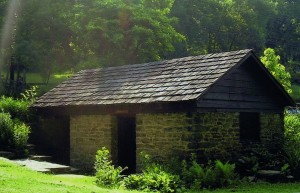 survival common to those who first settled Western Pennsylvania. Most of these frontier farmers were Scots-Irish immigrants; some were of Scottish, Welsh, or German descent. They were proud, frugal people with few possessions, determined to find good, cheap land and a better life.
survival common to those who first settled Western Pennsylvania. Most of these frontier farmers were Scots-Irish immigrants; some were of Scottish, Welsh, or German descent. They were proud, frugal people with few possessions, determined to find good, cheap land and a better life.
 In 1927 Allegheny County purchased the 65.286 acres of property that still belonged to the Miller family along with neighboring properties to become South Park.
In 1927 Allegheny County purchased the 65.286 acres of property that still belonged to the Miller family along with neighboring properties to become South Park.
In 1934, given the name “Stone Manse” and declared a national historic site, the Miller home was opened to the public. For a short period of time the building was furnished and under the care of the County Federation of Women’s Clubs. Later the home was staffed by an Allegheny County caretaker.
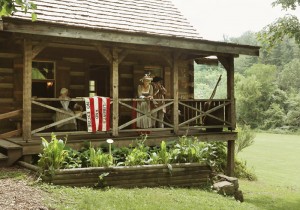 In 1973, a new dedicated volunteer organization, the Oliver Miller Homestead Associates, was given the approval of Allegheny County to be the official curators of the newly named Oliver Miller Homestead. Through the years, this all volunteer organization, with the help of Allegheny County’s Department of Parks, has improved the conditions of the house and grounds, added structures, and developed programs to educate the public on the Millers and eighteenth century life in western Pennsylvania.
In 1973, a new dedicated volunteer organization, the Oliver Miller Homestead Associates, was given the approval of Allegheny County to be the official curators of the newly named Oliver Miller Homestead. Through the years, this all volunteer organization, with the help of Allegheny County’s Department of Parks, has improved the conditions of the house and grounds, added structures, and developed programs to educate the public on the Millers and eighteenth century life in western Pennsylvania.
For more information on the Oliver Miller Homestead Associates, click: History of the OMHA
Inside the Stone House are six rooms that are usually all open to the public. 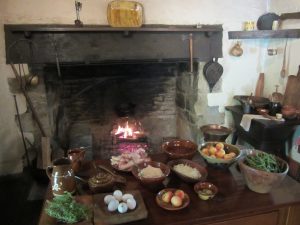 One room on the first level is set aside to demonstrate spinning and weaving. It houses an antique barn loom, a flax wheel, wool wheel and all equipment needed for the making of cloth on a frontier farm. A walking wheel is part of the furnishings in the Keeping Room.
One room on the first level is set aside to demonstrate spinning and weaving. It houses an antique barn loom, a flax wheel, wool wheel and all equipment needed for the making of cloth on a frontier farm. A walking wheel is part of the furnishings in the Keeping Room.
The kitchen, the oldest part of the Stone House, is attached to the back. Its large fireplace and hearth offer the perfect area for cooking demonstrations on special event days.
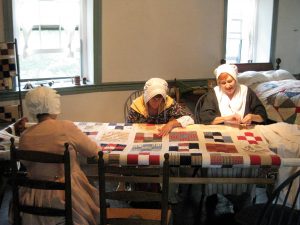 There are three bedrooms above the stairs. Ladies are often found working on a quilt in “Granny’s Room.” A small child’s room displays toys from the time and the James Miller bedroom is furnished with antiques.
There are three bedrooms above the stairs. Ladies are often found working on a quilt in “Granny’s Room.” A small child’s room displays toys from the time and the James Miller bedroom is furnished with antiques.
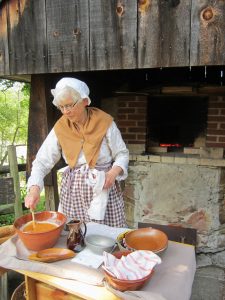 A decorative well that had been constructed in the 1930’s was remade into a working bake oven. Baking demonstrations take place on many special event Sundays.
A decorative well that had been constructed in the 1930’s was remade into a working bake oven. Baking demonstrations take place on many special event Sundays.
A two-story log house (pictured above) was built in 1988 as a reminder of the first Miller home. It is furnished with reproductions and antiques in keeping with the period. Each July, on Whiskey Rebellion Day, skits that depict the Miller family’s involvement in the Whiskey Rebellion of 1794 are held at the Log House.
In 1991 OMHA built a fully equipped blacksmith’s forge where volunteer blacksmiths demonstrate the making 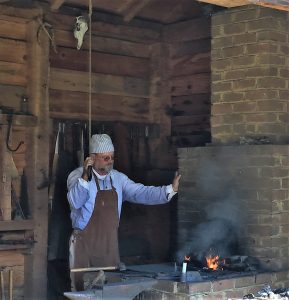 and repairing of basic items used on a farm.
and repairing of basic items used on a farm.
Beyond the forge is a demonstration shed where one might find a wood worker, horn smith, shingle maker or cooper at work.
At the far end of the Homestead property is a reproduction bank barn that was completed in 2005. The barn houses the Homestead’s gift shop, known as the Trading Post. It also has a 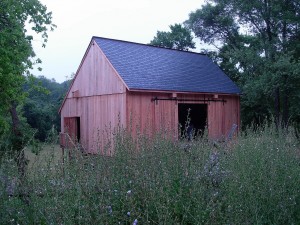 variety of farm tools, a children’s area, permanent and changing displays, information about the Whiskey Rebellion, and the original Miller whiskey still.
variety of farm tools, a children’s area, permanent and changing displays, information about the Whiskey Rebellion, and the original Miller whiskey still.
Among the many gardens on the property is the Constant Garden, which is a kitchen vegetable garden. a new addition is the dye  planted garden in back of the Stone House. Emily’s Garden, a woodland wildflower garden, is located under the large sugar maple tree near the bake oven. It is very beautiful in the early spring when the trillium, blue bells and wild phlox are in bloom. More flower gardens are found along the fence and bear the spring house. A medicinal herb garden is located behind the Log House, while farm crops can be found in small plots in the field below the Homestead. All of these gardens are planted and maintained by OMHA volunteers.
planted garden in back of the Stone House. Emily’s Garden, a woodland wildflower garden, is located under the large sugar maple tree near the bake oven. It is very beautiful in the early spring when the trillium, blue bells and wild phlox are in bloom. More flower gardens are found along the fence and bear the spring house. A medicinal herb garden is located behind the Log House, while farm crops can be found in small plots in the field below the Homestead. All of these gardens are planted and maintained by OMHA volunteers.
Click for a map of the Oliver Miller Homestead Site: MAP of OMH SITE
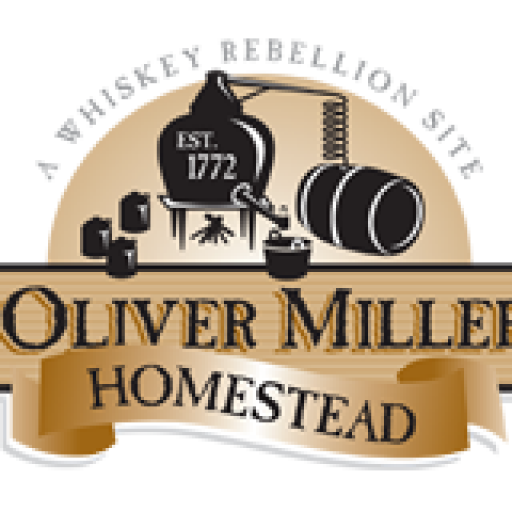
Oliver miller is so cool
Looking forward to the reunion and Whiskey Rebellion, it will be my 1st visit during open hours!